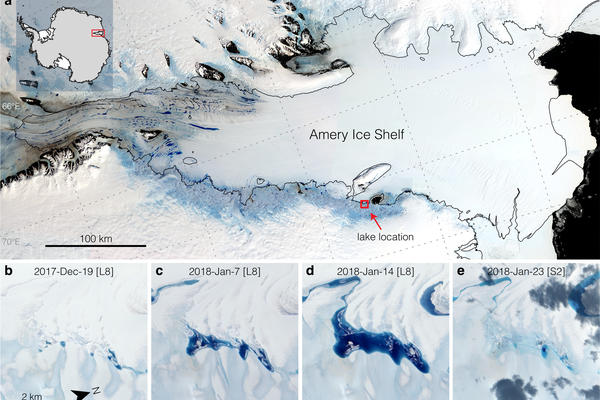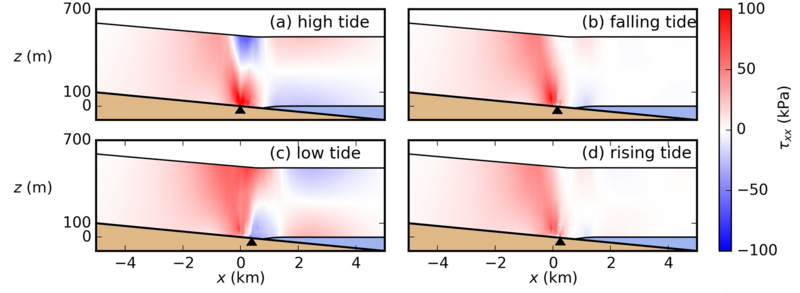Tough break-up: how ocean tides are fracturing Antarctica’s ice shelves

The Amery Ice Shelf and satellite imagery showing supraglacial lake drainage in the grounding zone (Trusel et al. 2022, Figure 1, available at https://doi.org/10.1029/2021GL095661)
As global temperatures rise, Antarctica’s floating ice shelves are under pressure. When the ice melts, water gathers in topographic lows on the surface to form supraglacial lakes, which drain into the Southern Ocean and contribute to sea level rise. Scientists have observed that the zone where the ice transitions from sitting on top of bedrock to floating (known as the “grounding zone”) sees lots of these lakes forming every year. But this is cause for concern, because the health of the grounding zone impacts how fast ice flows into the sea – and melting here could cause fractures which lead to destabilisation, iceberg calving and increased mass loss.
A team of researchers from Oxford Earth Sciences have modelled the complex behaviours of the Amery Ice Shelf, Antarctica’s third largest, in order to discover which processes could be causing the ice in the grounding zone to fracture apart.
In “grounded” ice on the Antarctic continent, supraglacial lakes cause fracturing when they become too large and the weight of the water breaks apart the ice below (a process known as hydrofracturing). The water then drains into these fractures, leaving behind a smaller, or empty, lake.
But until recently, very little was known about how hydrofracturing occurs in the grounding zone. In 2022, a research team from the US reported that lakes in the grounding zone of the Amery Ice Shelf drained without reaching a threshold volume. This finding forced scientists to consider an alternative hypothesis: that the tides are causing this hydrofracturing. In response, the authors of this study decided to test this hypothesis with computer simulations.
“Like a diving board, ice shelves experience large stresses when flexed. In particular, low tides can cause ice shelves to fracture at the surface, because the upper side of the ice shelf becomes extended and stretched until it breaks. This introduces vulnerability in the shelf and encourages supraglacial lakes to drain through the ice and into the ocean, contributing to sea level rise.”
- Hanwen Zhang, Lead Author of the Study

Tidal response of a marine ice sheet at different tidal phases, from the model results. Panels a-d show deviatoric tensile stress τxx in one tidal period, with red indicating tensile stress and blue indicating compressive stress. The black triangle marks the position of the GL. (Zhang et al., 2025, Figure 2, available at https://doi.org/10.5194/tc-19-2087-2025)
The new study, published recently in the journal The Cryosphere, modelled this process, allowing for the ice to behave in a visco-elastic way – both storing energy (elastic behaviour) and dissipating energy (viscous behaviour) when deforming under stress. They also allowed the exact point the ice detaches from underlying rock and starts to float (the “grounding line”) to move forwards and backwards within the grounding zone, a process which is supported by observations at the Amery Ice Shelf. This permitted the team to get a much more accurate picture of how the ice shelf flexes with the tide.
As a result, the researchers were able to show that the tides are a significant cause of stress in the grounding zone, and that this process makes the ice shelf more vulnerable to hydrofracturing. At low tides, large stresses are generated at the surface of the ice shelf, breaking apart the ice and allowing meltwater to enter these fractures. The water then erodes through the ice, creating a drainage pathway for the overlying lakes. When the tidal amplitude increases, the stresses on the ice shelf also increase.
The modelling results also aligned with observations of supraglacial lake drainage from satellite images, verifying the authors’ theory.
The findings showed the unique responses of the grounding zone of ice shelves to stress, and highlighted that the influence of the tides was significantly larger in the grounding zone than further inland. By modelling ice deformation as visco-elastic, the research team were also able to accurately describe how the ice shelf flexes on intermediate timescales – which proved vital for unlocking this overlooked mechanism of ice shelf stress. It is hoped that these results will help scientists to develop more sophisticated models of the Antarctic Ice Sheet, and contribute to more accurate predictions of the fate of this continent in a warming world.
The study ‘Viscoelastic mechanics of tidally induced lake drainage in the grounding zone’ is available to read in the journal The Cryosphere at https://doi.org/10.5194/tc-19-2087-2025.




